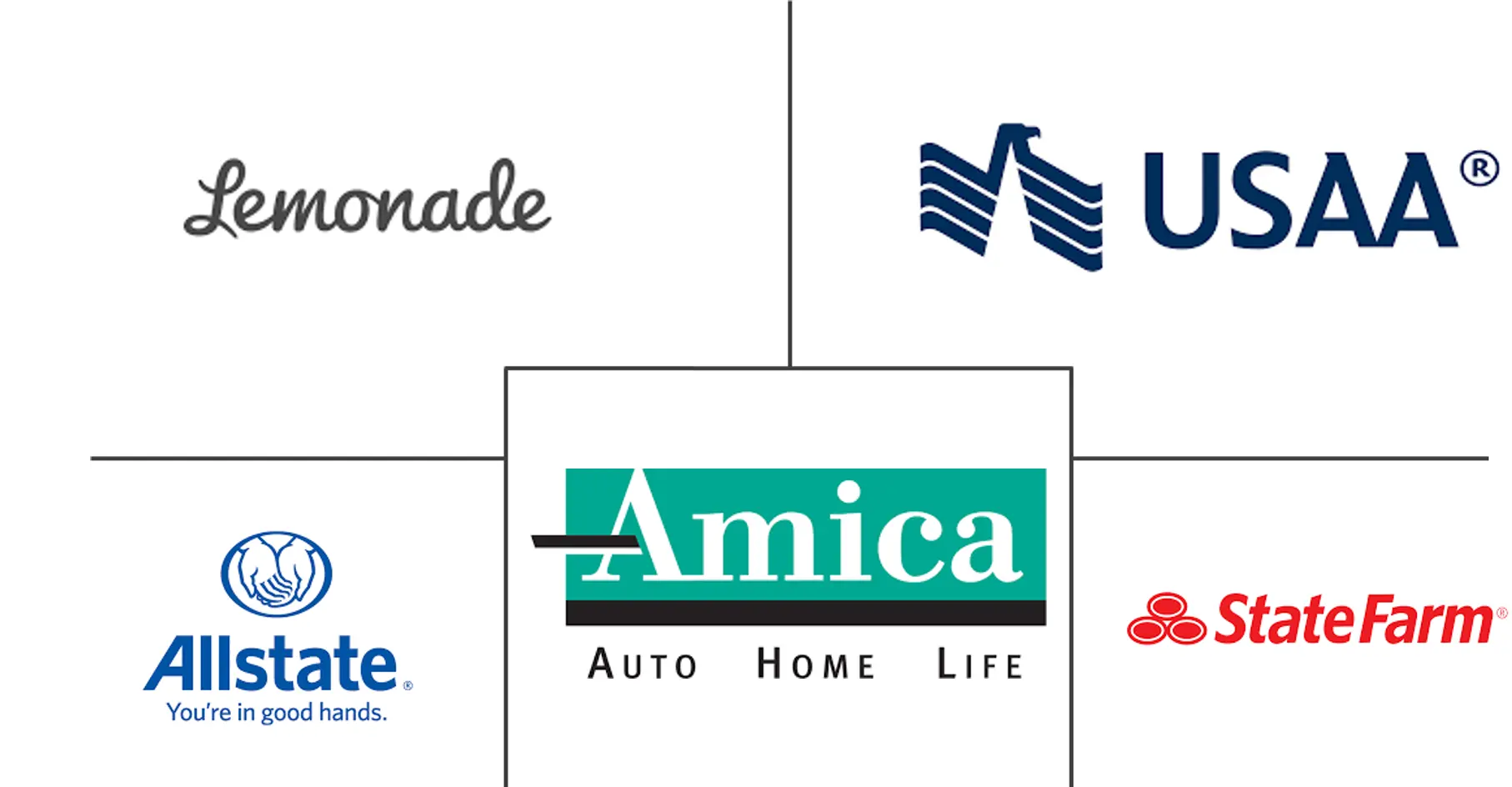United States Homeowners Insurance Market Size and Share
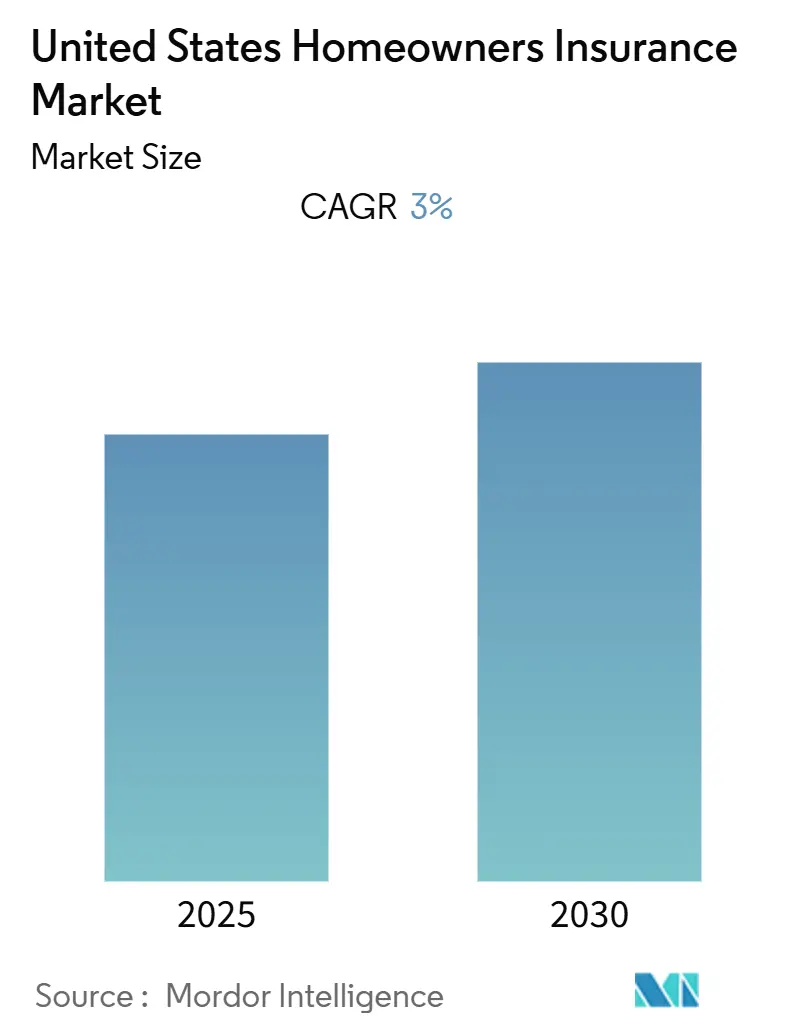
United States Homeowners Insurance Market Analysis by Mordor Intelligence
The United States Homeowners Insurance Market is expected to register a CAGR of 3% during the forecast period.
The property/casualty insurance sector is one of the highly valuated sectors in the market in the current scenario, irrespective of the increases in pricing and a low-interest rates. Due to the catastrophic concerns, the property/casualty insurance industry stood at approximately $800 Billions.
COVID-19 experience during the first quarter of 2020 demonstrated, pandemic-related losses are correlated with both financial market losses and other insurance losses. During the first quarter of 2020, the policyholder surplus of the United States property-casualty insurance industry fell by 9.3% to $744.9 billion, due in large part to a sharp decline in asset prices as well as the establishment of COVID-19 loss reserves across numerous lines of insurance.
The profits generated by insurance companies are accounted for by investment income from capital and surplus reserves. Money is set aside as loss reserves and unearned premium reserves in the United States. From underwriting operations, whenever there are losses, they are offset from their investment planning.
United States Homeowners Insurance Market Trends and Insights
InsurTech in the United States Homeowner's Insurance
Sustained economic growth, coupled with higher interest rates and bigger investment income, helped the United States insurance industry to top the charts with impressive growth. Even though the traditional insurance companies are doing well, to withstand newer business models, they are coming forward to partner with Insurtech companies. In fact, this partnership helps the traditional players to better cater to the customer demands without investing much in R&D for self-made technology. InsurTech companies manage many niche segments of the market, ranging from operating as Distributors/Aggregators, API developers, HealthTech, Online First Insurance providers, and IoT, amongst others.
Among all, the Property/casualty sector has been doing well with a 12.7% increase in the first half of 2018. The Online first insurance: As the name suggests, these companies offer insurance products completely online and connect various distribution channels. For example, Lemonade is an online-first P2P insurance platform that offers home insurance in New York, California, and Illinois. The technology used is AI and Behavioral economics. Another example would be Next Insurance, which is also an online insurance platform that targets SMEs, entrepreneurs who are looking for insurance to cover their business. Hippo, an online platform, provides home insurance products.
The Internet of Things: These companies are using technology to reduce the premium amounts for the insurance taken and creating a digital disruption. For example, American Well, a web and mobile-based platform founded in 2006, and then there is a start-up named Metromile, which turns an ordinary car into a smart car with a plug-in device that calculates the miles travelled to find out the insurance to be paid.
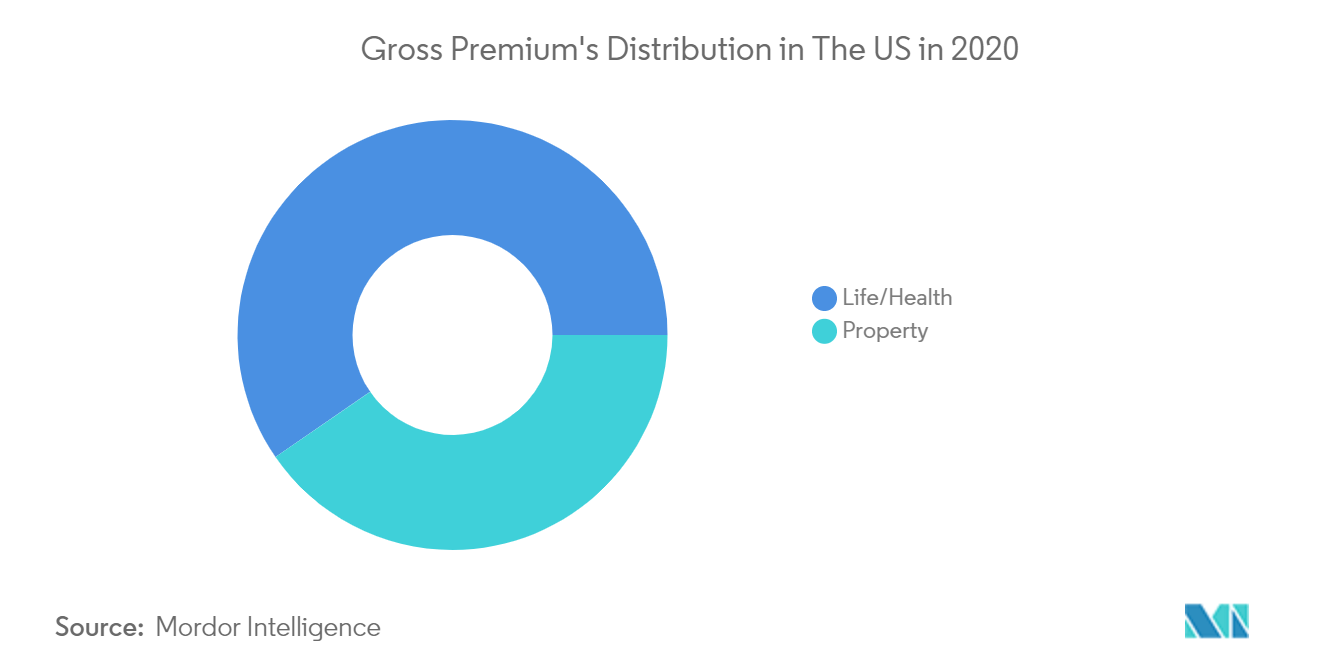
Natural Catastrophes affect Spending on Homeowner’s Insurance
Homeowners insurance is a package policy, providing both property and personal liability insurance. The typical policy covers a house, garage, and other structures on the property well as personal property inside the house-against a wide variety of perils, such as fire, windstorm, vandalism, and accidental water damage. The typical homeowner's policy includes theft coverage on personal property anywhere in the world and liability coverage for accidental harm caused to others. It also reimburses the policyholder for the additional cost of living elsewhere while a house is being repaired or rebuilt after a disaster.
Standard homeowners' policies do not cover earthquake damage and flood damage caused by external flooding; however, special policies can be purchased separately. Flood coverage is provided by the federal government's National Flood Insurance Program and some private insurers.
Storm surge is ocean water that is pushed ahead of a storm and can cause severe damage. States along the U.S. Gulf of Mexico and Atlantic Basin are potentially vulnerable to storm surge damage. In 2019, there were 7.3 million coastal homes along the Gulf and Atlantic Coasts, worth almost USD 1.8 trillion, at risk for storm surge damage. Along the Gulf Coast, 3.1 million homes are at risk from storm surge, and another 4.1 million homes along the Atlantic Coast are at risk. The reconstruction cost value of homes at risk for storm surge damage is USD 668 billion along the Gulf of Mexico in the United States and USD 1.1 trillion along the highly populated Atlantic Coast. The reconstruction cost is based on the 100 percent destruction of the residential structure, using a combined cost of construction materials, equipment, and labor costs by geographic location.
The State Farm Mutual Automobile Insurance from Bloomington, Illinois, was the leading homeowners insurance writer in the United States in 2020. With almost USD 20 billion in direct premiums written, this insurance company toppled the second homeowner insurer (Allstate Corp.) in the United States by around USD 10 billion in that year.
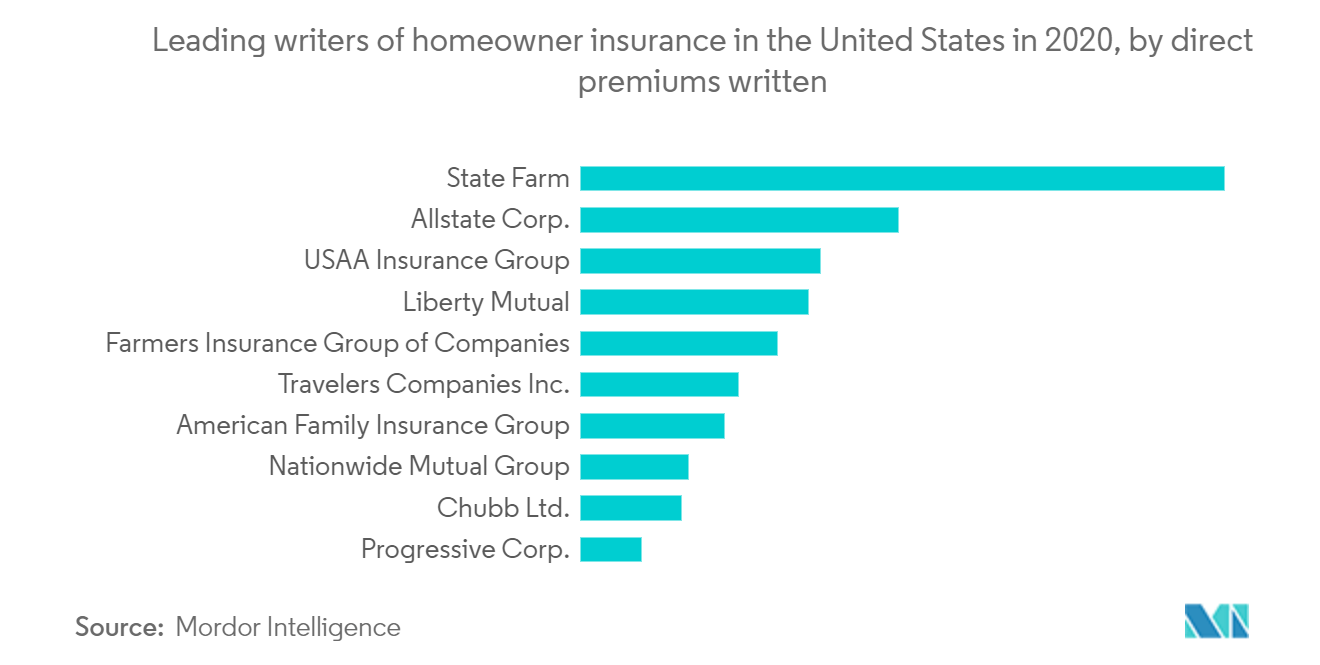
Competitive Landscape
The US HomeOwner's Insurance Market is highly competitive, with the presence of major international players. The US HomeOwner's Insurance Market presents opportunities for growth during the forecast period, which is expected to further drive market competition. With a few players holding a significant share, the US HomeOwner's Insurance Market has an observable level of consolidation.
United States Homeowners Insurance Industry Leaders
-
State Farm
-
Allstate
-
Liberty Mutual
-
USAA
-
Farmers
- *Disclaimer: Major Players sorted in no particular order
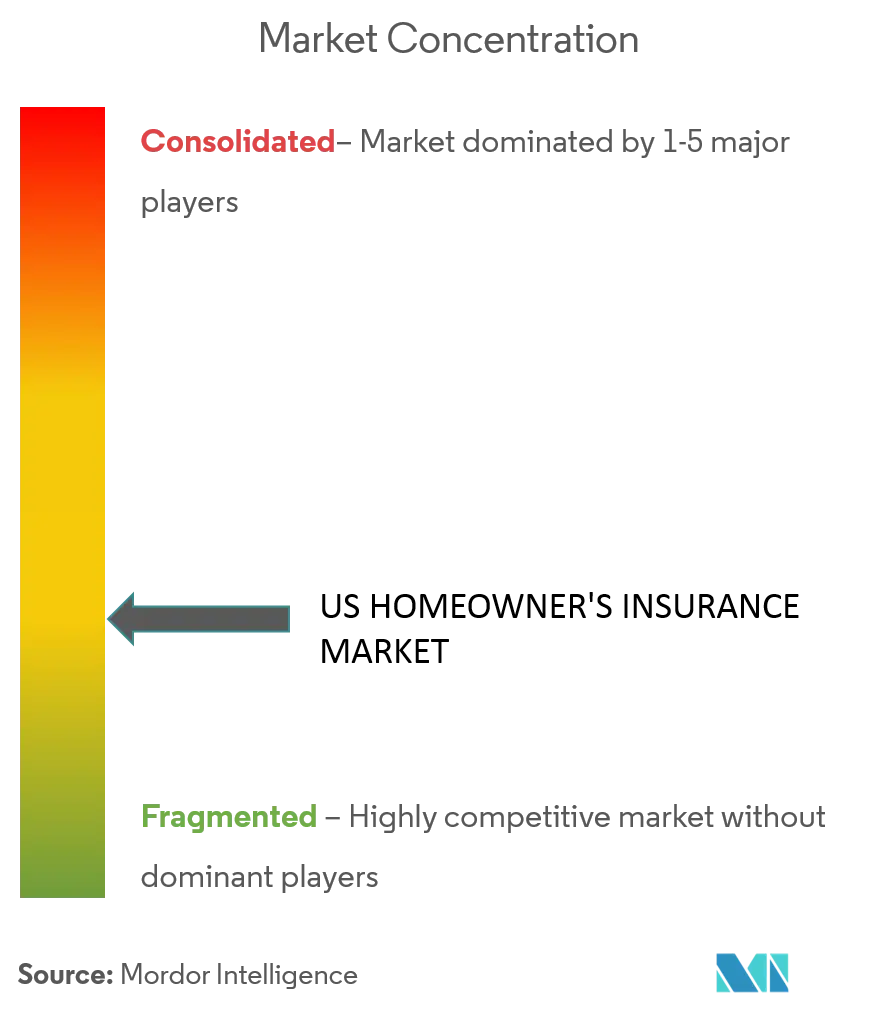
Recent Industry Developments
- in 2020: to $51.6 million, from $103 million in 2019
United States Homeowners Insurance Market Report Scope
The United States Homeowners Insurance Market is segmented by countrywide mostly available homeowner's insurance types like HO-1, HO-2, HO-3, HO-5, HO-8, and by the distribution channels operated in the United States Homeowners Insurance sector.
| Dwelling Fire |
| HO-1 |
| HO-2 |
| HO-3 |
| HO-5 |
| HO-8 |
| Independent Advisers |
| Affiliated Agents |
| Direct Sales |
| Online Channels |
| Others |
| HomeOwners' Insurance Type | Dwelling Fire |
| HO-1 | |
| HO-2 | |
| HO-3 | |
| HO-5 | |
| HO-8 | |
| Distribution Channel | Independent Advisers |
| Affiliated Agents | |
| Direct Sales | |
| Online Channels | |
| Others |
Key Questions Answered in the Report
What is the current US Homeowner's Insurance Market size?
The US Homeowner's Insurance Market is projected to register a CAGR of 3% during the forecast period (2025-2030)
Who are the key players in US Homeowner's Insurance Market?
State Farm, Allstate, Liberty Mutual, USAA and Farmers are the major companies operating in the US Homeowner's Insurance Market.
What years does this US Homeowner's Insurance Market cover?
The report covers the US Homeowner's Insurance Market historical market size for years: 2020, 2021, 2022, 2023 and 2024. The report also forecasts the US Homeowner's Insurance Market size for years: 2025, 2026, 2027, 2028, 2029 and 2030.
Page last updated on:
United States Homeowners Insurance Market Report
Statistics for the 2025 United States Homeowners Insurance market share, size and revenue growth rate, created by Mordor Intelligence™ Industry Reports. United States Homeowners Insurance analysis includes a market forecast outlook for 2025 to 2030 and historical overview. Get a sample of this industry analysis as a free report PDF download.
